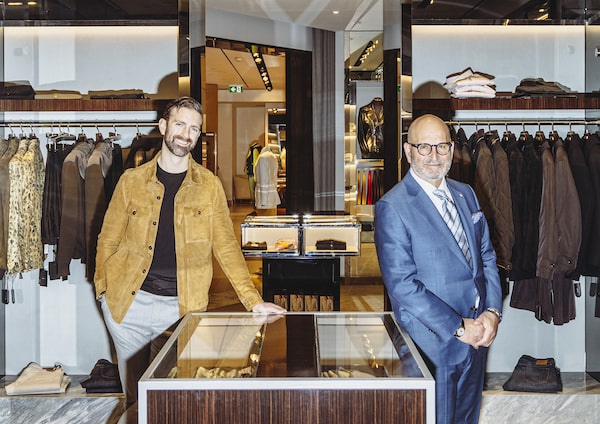
Chairman and CEO Larry Rosen, right, and president and COO Ian Rosen survey the company's flagship Harry Rosen store in Toronto on March 13.Carlos Osorio/The Globe and Mail
There is a kind of irony to the fact that the future site of Harry Rosen Inc.’s new flagship store in Toronto includes two floors of office space, which currently sit empty.
The same forces that have put the squeeze on commercial real estate in some of Canada’s biggest cities – with many people working from home more often – have also reshaped men’s fashion. And the menswear retailer, known for decades for its suits, has been forced to adapt.
“The last four years have been a total reinvention of how people dress, and how men dress,” said chairman and chief executive officer Larry Rosen, whose father, the late Harry Rosen founded the business with a small made-to-measure men’s store 70 years ago. “The other thing that really changed was the way that men shop.”
During the pandemic, the company expanded its casual-wear offerings, branched out into grooming and personal care products, and spent more than $5-million to bring its digital operations into the 21st century. E-commerce has ballooned from 4 per cent of sales before the pandemic to roughly 20 per cent today.
While the pandemic was a bumpy ride for all retailers, Harry Rosen included, the business is continuing to grow, with record revenues last year approaching $350-million.
Now, Harry Rosen is embarking on a $50-million plan to overhaul its entire store network over the next five years.
The company has 19 stores across Canada, including five outlet locations. The plan will add one store, in Vancouver’s Oakridge Park development, as well as move the Toronto flagship from Bloor Street (where the 40-year lease is up, and the building is being redeveloped) to three floors around the corner in the upscale Yorkville neighbourhood, opening in 2026. The rest of the stores will undergo major updates, with smaller renovations planned for the outlets. The first will be completed at West Edmonton Mall this year.
The idea is to adapt the stores to changing styles and shopping habits. They plan to build more hidden storage space in the customer service area, for example, for quicker access to online purchases for pick-up. Suits and tailored clothing will be concentrated in slightly less space, rather than spread out. Displays will change up regularly, showcasing some of the “more advanced fashion” labels the store has brought in recently – such as Kenzo, Thom Browne and Marni – and demonstrating how to put items together, to give customers a reason to shop in person.
In some ways, the store design is catching up with changes Harry Rosen has already made to its product mix. Before the pandemic, tailored clothing and formal wear made up nearly 60 per cent of the business; now it’s closer to 40 per cent. Roughly half its footwear sales are in casual shoes and sneakers.
“Trust me, if we’d been speaking four years ago, I would have had a tie on and been way more formal,” said Mr. Rosen (who may have relinquished the tie, but still dons a blue suit for this meeting.) “And he would have too,” he adds, gesturing to his son, president and chief operating officer Ian Rosen, who is wearing a less-structured, soft jacket – the retailer’s fastest-growing category – over a crewneck sweater.
The Rosens believe that changes to men’s fashion can be an opportunity for the stores, where staff can help customers unsure of how to choose the right cut as pants become wider, or how a less-structured jacket should fit them.
“We’ve been over-focused on making sure that there’s this focus on styling,” Ian Rosen said.
Even as many Canadians have cut back on spending, as they feel the sting of inflation and rising interest rates, the $900-million men’s luxury apparel market has continued to grow, with sales up more than 5 per cent in 2022 and an estimated 8 to 10 per cent last year, according to market research firm Trendex North America.
Harry Rosen’s last major capital investment was in 2014, when the company spent roughly $100-million to enlarge most of its stores, adding roughly 75,000 square feet of space across the country. The push was a response to American department stores expanding into Canada – Nordstrom Inc. in 2014, and Saks Fifth Avenue in 2016.
Now, the landscape looks very different. Nordstrom shut down its 13 stores in Canada last year. Saks has just a few full-price locations in Canada. At the same time, Harry Rosen continues to face competition from another Canadian luxury retailer, Holt Renfrew. And more designers – the same ones that are Harry Rosen’s wholesale partners – have been opening up their own standalone boutiques.
“Our competitive set is different than it was even five years ago,” Larry Rosen said. “The department store has become irrelevant. We’re still – not just standing, we’re thriving. And it’s because first of all, we have a passionate leadership team and a passionate family that is committed to it. Over the years, everybody’s offered to buy us. That’s never been a consideration. Keeping this a multigenerational family business that’s Canadian, and keeping us relevant to the market, has always been our passion.”
The company sees the store investment as part of its effort to continue fighting for market share in Canada.
“We could have taken that capital and invested it a number of different ways,” Ian Rosen said. “... We feel like this is the best way for us to realize that vision. It’s not to go international. We’re very proudly Canadian. We want to make sure that this infrastructure that we built over the last 70 years evolves.”
 Susan Krashinsky Robertson
Susan Krashinsky Robertson